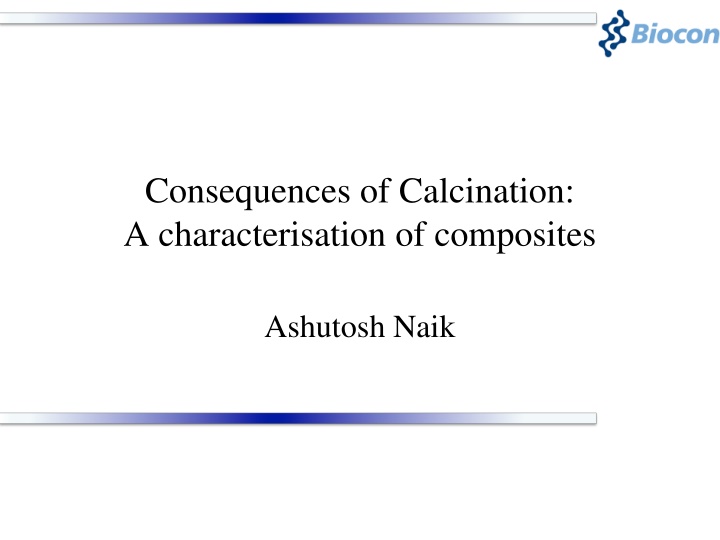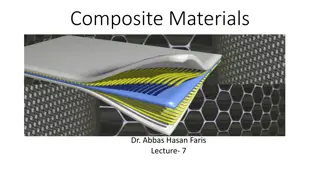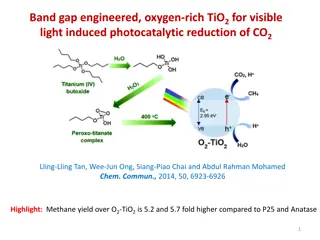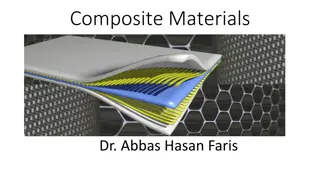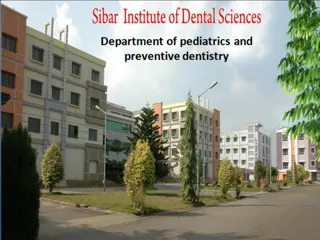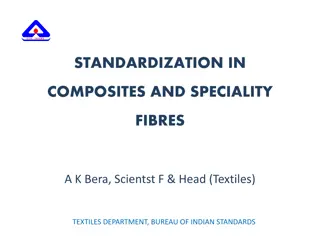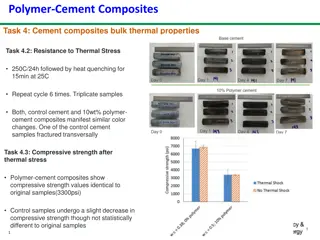Consequences of Calcination on Composites Characterization
In this study by Ashutosh Naik, the impact of calcination on composites, particularly focusing on the use of hydroxyapatite (HA), is explored. The process of calcination and its effects on surface OH groups, degradation, and mechanical properties are investigated. HA synthesis methods, composite production techniques, and temperature profiles for calcination are discussed. The study highlights the importance of calcination atmosphere in altering filler properties and composite performance.
Download Presentation

Please find below an Image/Link to download the presentation.
The content on the website is provided AS IS for your information and personal use only. It may not be sold, licensed, or shared on other websites without obtaining consent from the author.If you encounter any issues during the download, it is possible that the publisher has removed the file from their server.
You are allowed to download the files provided on this website for personal or commercial use, subject to the condition that they are used lawfully. All files are the property of their respective owners.
The content on the website is provided AS IS for your information and personal use only. It may not be sold, licensed, or shared on other websites without obtaining consent from the author.
E N D
Presentation Transcript
Consequences of Calcination: A characterisation of composites Ashutosh Naik
Focus Points Introduction Aims Materials and Methods Results Conclusion
Introduction Bone is a composite at the nanoscale. *Jae Young Rho, Liisa Kuhn Spearing, Peter Zioupos- Mechanical properties and the hierarchical structure of bone. Medical Engineering and Physics. 20 1998, 92-102.
Introduction HA (Ca10 (PO4)6(OH) 2) is used as a filler in polymer based composites. One of the ways of altering the properties of the filler is calcination. The atmosphere in which the calcination is carried out may also influence the properties of the filler and hence that of the composite.
Aims Calcination of Hydroxyapatite (HA): Presence of surface OH groups. Consequences: Effect on degradation and mechanical properties.
Materials and Methods HA synthesis Composite production Degradation study Mechanical properties
HA Synthesis Synthesis of HA: HA was synthesized using an aqueous precipitation method based on the following formula 10Ca (OH)2+ 6 H3PO4 Ca10 (PO4)6 (OH)2 + 18H2O The HA synthesised was then calcined in an atmosphere of air (calcined in air) as well as an atmosphere of humidified argon (calcined in wet) or left untreated (uncalcined HA). The three powders were used as fillers in composites produced.
Temperature profile for Calcination Fig: Temperature profile for calcining of HA powders
Composite production PLGA (50:50) (Lakeshore Biomaterials) was used as the polymer and composites containing 30-wt% HA were produced. The composites were produced using two steps; -Solvent casting using acetone followed by -Injection moulding (12cm3, DSM Xplore). Conditions Mould temperature Melt temperature Injection pressure Filling and holding pressure Values 35 C 140 C 5.0 bar 2.0 bar each Holding time 3-6 seconds
Degradation study Cylindrical shaped specimens produced using the method described were cut into discs of 2mm x 2mm using the Struers Accutom5(cutting speed 0.015-0.050m/s). The samples were then immersed in PBS in the ratio of 6mg/ml. Total number of time points =24 Number of repeats = 3 Total number of samples =216
Mechanical properties Elastic mechanical properties: DMTA (DMA Q800, TA Instruments, USA) was used. Dumbbell shaped specimens were used. Three repeats were carried out for each sample. Conditions Values Sample length 35mm Sample width 4.1 mm Sample thickness 2.1 mm Frequency 1, 10, 20,50 Hz Temperature -10 C to 120 C Heating rate 3 C/min
Mechanical properties Plastic mechanical properties: The Hounsfield (5 kN) machine was used. Cylindrical shaped specimens were used. The dimensions of the samples were 12mm x 6mm. Three repeats were carried out for each sample.
Results XRD spectrum of HA. Effect of calcination- Degradation study. Degradation Schematic. Effect of calcination- Mechanical properties.
Effect of calcination- Elastic mechanical properties
Effect of calcination- Elastic mechanical properties
Effect of calcination- Plastic mechanical properties
Conclusions Calcination in different atmospheres improves the buffering effect of filler thus leading to a better degradation profile of the composite. The values of dynamic storage modulus (E ) obtained under elastic loading conditions 5.8( 0.5)GPa,6.3( 0.5)GPa for HA calcined in an argon atmosphere and HA calcined in air were much higher compared to 3.1( 0.3) GPa for uncalcined HA.
Conclusions The competing effects of particle-mediated water absorption and buffering have been demonstrated. Further studies need to be conducted to understand the effect of calcination temperature on the properties of a composite.
